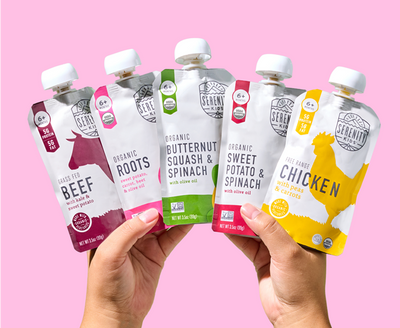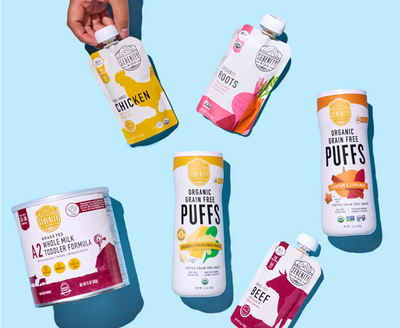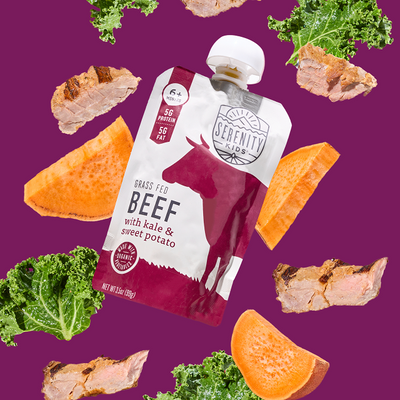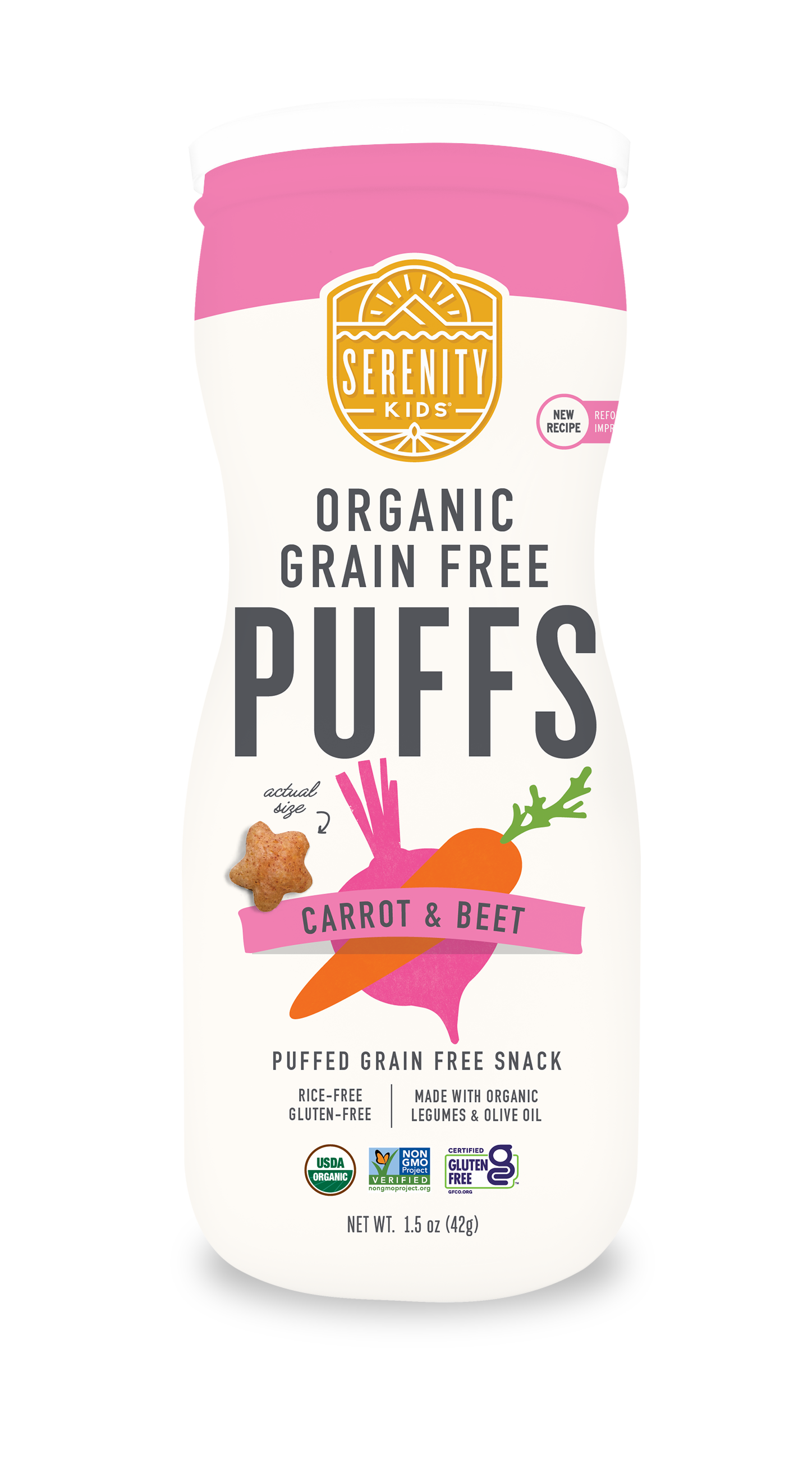Purees can play a major role in your little one's early feeding journey. They introduce your baby to a whole new world of flavors while also providing key nutrients to support healthy growth and development at an especially critical time.
The time when purees are introduced, around six months, is known as the beginning of the "flavor window." It offers a prime opportunity to expose your baby to a diverse range of tastes to help shape their future preferences.
When creating these first purees, it's important to keep a few things in mind. Aim to fill them with a balance of proteins, fats, and colorful vegetables. Added sugars, honey, salt, processed ingredients, and grains (which can be more difficult to digest at this stage) are best avoided.
Let's take a look at signs of readiness, nutrition needs, and then explore some nutrient-packed puree recipes to inspire your baby's taste buds.
How Do I Know If My Baby Is Ready?

Babies are typically ready to start solids around 6 months of age, but looking for signs of readiness is more important than a specific age. Your baby might be ready for you to start introducing solids when he or she:
- Can sit upright well without support
- Has lost the tongue-thrust reflex (doesn’t automatically push solids out of the mouth with the tongue)
- Has good head control (does not bob or nod when unsupported)
- Is willing and able to chew (even if he or she does not yet have teeth)
- Is developing a pincer grasp (picks up food or other objects between thumb and forefinger)
- Is interested in food and is eager to participate in mealtime (may watch you closely as you eat, lean into food, or try to grab food off of your plate)
Of course, you don't have to stick to just purees, you can also introduce finger foods as you and your baby feel comfortable.
Nutritional Needs for Babies: A Quick Look

While breast milk or formula remains a primary source of nutrition for babies throughout their first year, solid foods are a great way to add in key nutrients for babies. Purees are a great way to pack in a lot of nutrients. Since baby bellies are small, so are portion sizes (think a tablespoon or two to start). That's why #everybitecounts!
Some key nutrients to focus on at this stage include the following:
Iron
Most newborns have enough iron stored in their bodies for about the first 6 months of life, depending on factors like gestational age and maternal iron levels. By 6 months, though, infants typically require an external source of iron. Babies aged 7-12 months need around 11 mg of iron daily to support growth and brain development. Iron-rich foods like small pieces of chicken, beef, and lentils can be pureed into baby-friendly recipes that ensure they get this vital nutrient.
Zinc
Zinc supports growth, neurological function, and immune health. A deficiency in zinc can impair physical development and increase susceptibility to infections. Foods rich in zinc include meats like pork, beef, and chicken, as well as seafood, particularly shellfish. Pureed dishes with meats and a pinch of salt (if recommended by your pediatrician) can help provide sufficient zinc intake.
Choline
Choline aids brain and nervous system development, regulating memory, mood, and muscle control. Foods high in choline include eggs, fish, and pork. You can puree eggs or blend small amounts of cooked salmon baby food, adding a bit of smooth yogurt for creaminess if desired.
Omega-3 Fatty Acids
Omega-3s, particularly DHA, are essential for infants as they support cerebral cortex development. This part of the brain is responsible for motor function, language, and sensory processing. Omega-3-rich foods include fish like salmon and trout. Puree recipes that incorporate these fish, cooked and blended to a smooth consistency, offer a tasty way to introduce these essential fats.
Vitamin C
Vitamin C is essential for immune function, helps absorb iron, and supports skin and bone health. It’s naturally abundant in fruits like strawberries, blueberries, and apples, as well as vegetables like potatoes and carrots. A homemade baby puree with boiled potatoes, a bit of apple, and strawberries or blueberries provides a flavorful and nutrient-packed dish for babies. Try sprinkling a tiny bit of cinnamon or nutmeg to enhance taste while making it fun and appealing.
Nutrient-Packed Puree Recipes

One of the benefits of purees is that you can pack a whole lot of nutrition into an easy-to-eat puree. You can also blend as much or as little as you'd like to make it completely smooth or to add a little texture.
Here are some nutrient-dense homemade puree recipes to try with your little one. Remember to portion them into small amounts and then freeze extras for future meals.
Recipe 1: Thanksgiving-inspired turkey and pumpkin puree
This is a great way to get your baby some meat (learn more about why meat is great for babies here!). It's quick and easy to blend up and is full of healthy protein and fat, plus vitamins, minerals, and gut-supporting bone broth.
- 1/4 lb cooked turkey (cooked chicken works too)
- 1/2 c cooked pumpkin puree
- 1/2 avocado
- 1/2 c turkey bone broth (or any bone broth)
- pinch of Himalayan sea salt
Blend all of the ingredients (cooked where necessary) to your desired consistency.
Recipe 2: Baked Sweet Potato Puree
Simple but delicious. Bake sweet potatoes in the oven or saute them over medium heat until soft. Scoop out the inside, add water, breast milk, or formula to thin it out a bit, and then add a healthy fat like olive oil, nutrient-dense bone marrow, or even cottage cheese. Then, blend it all with an immersion blender.
You can also jazz this up with herbs or dulse seasoning - a salt-free seaweed seasoning that is a good source of iodine.
Recipe 3: Beef and veggie bone broth puree
A great way to get the benefits of beef, this simple puree packs a nutritional punch. Simply saute grass-fed ground beef along with vegetables of choice. A root vegetable like sweet potato works best alongside some leafy or cruciferous vegetables like broccoli or kale. You can also add any veggies you have on hand, like frozen peas. Add a splash of bone broth to help the beef cook and the veggies soften. Once everything is cooked and soft, allow it to cool slightly. Puree it all in a stand blender or immersion blender, adding more bone broth as needed to get it to your desired consistency. Once cooled, you can add a squeeze of fresh lemon juice if you'd like.
The Importance of Convenience
Of course, we know that life with a little one can be hectic. Homemade might not always happen, and that's when you turn to convenience.
Serenity Kids has a variety of delicious and nutritious fresh baby food pouches made with the same high-quality ingredients you'd want to use in your own home. They're perfect for busy days or on-the-go feeding.
Pro Tips for Puree Success
Preparing nutrient-rich purees for your baby can be simple and enjoyable with a few key tips. Whether you’re using frozen fruits, blending leftovers, or adding a pinch of flavor, these strategies make the process smooth and time-saving for busy parents.
Selecting Produce:
Choosing fresh, ripe veggies and fruits will give you optimal flavor and nutrition. The Dirty Dozen is a good guide for buying organic on a budget. Frozen fruits and veggies also work well in puree recipes since the texture doesn't have to be perfect - it gets blended anyway!
Pureeing Techniques:
You'll want to cook (steaming and sauteeing work well) any ingredients in your purees first, then blend them using a high-powered stand blender, food processor, or immersion blender.
Freezing Purees:
Freezing is a great way to batch cook and save time later. Portion purees into freezer-safe containers (silicone ice cube trays work well!) and label them with the date.
Aim to use frozen purees within about 3-4 months (and remember, your little one might not even care for purees in four months!).
Other Time-Saving Tips:
To save time on meal prep for the whole family, consider using the veggies and proteins that you're already preparing for your family that week to make a puree for your little one. If you have some great seasonal or local foods for a dish for yourself, chances are, your little one will love them in blended form. Remember to add herbs and spices for flavor too.
How to Safely Store and Serve Homemade Baby Purees

Preparing nutrient-rich puree recipes for your baby is a rewarding way to ensure they receive the freshest and healthiest foods. But once you’ve created these delightful dishes, storing and serving them safely is essential to maintain their nutritional value and flavor. Here are practical tips to help you store and serve homemade baby purees, so every meal is fresh, safe, and nutritious for your little one.
Storing Homemade Purees
Portioning for Freshness
After cooking your puree recipes, divide them into small portions. Freezing in small pieces, like in silicone ice cube trays, allows you to thaw only what you need for each meal. This reduces waste and ensures that your baby’s food stays fresh.
Freezing Purees Properly
To keep the flavor and nutrients intact, freeze your purees immediately after they cool down. Place each portion into a freezer-safe container and label it with the date. Most purees, including potato, apple, and carrot baby puree, can last in the freezer for up to three months. When freezing creamy purees that contain dairy, like those with yogurt or cheese, use them within one month to preserve quality.
Thawing and Reheating Tips
Thaw purees in the fridge overnight or by placing the container in a bowl of cold water. Reheat purees until they are warm, not hot, to avoid burning your baby's sensitive mouth. Avoid microwaving, as it can create hot spots; instead, stir the puree thoroughly after heating on the stove or using a bowl set in warm water for even temperature distribution.
Maintaining Texture and Flavor
As purees thaw, they may lose some moisture or become grainy. For a smooth and creamy texture, add a splash of more milk, yogurt, or cold water, stirring well to reach the desired consistency. This is especially useful for foods like potatoes and other starchy vegetables, which can thicken as they cool.
Keeping Purees Free from Contaminants
To ensure your purees remain safe, always use clean utensils and containers when handling them. Avoid double-dipping spoons and keep unused portions sealed tightly. Freshly prepared food is safest for your baby, so try to avoid refreezing purees that have been thawed.
Serving Tips for Baby Purees
Balancing Taste with Texture
Babies often enjoy purees that have a smooth, creamy consistency. Adding a dash of spices like cinnamon or nutmeg can enhance the taste, especially in recipes with apples or sweet potatoes. Just remember to avoid adding salt or brown sugar, as babies don’t need extra sodium or sugar in their diets.
Experimenting with Flavor Combinations
Introducing babies to various flavors early on can help shape their preferences. Try mixing fruits and vegetables, like apple and carrot or banana and yogurt, for a naturally sweet dish that your baby will love. Adding a small piece of cheese to vegetable purees can also add depth to the taste.
Serving Size Ideas
Babies have small stomachs, so start with just a tablespoon or two. Gradually increase the serving size as your baby grows and shows more interest in food. For richer textures, try thicker purees with ingredients like potato, cream, or yoghurt.
Creating a Positive Mealtime Experience
Serving homemade purees in a relaxed setting helps your baby associate food with fun and comfort. Ensure the puree is at room temperature and serve in small amounts. This keeps the meal safe and encourages your baby to enjoy each bite without feeling overwhelmed.
Incorporating Nutrient-Rich Ingredients
Mixing in nutrient-dense ingredients like vegetables, fruits, and proteins provides your baby with essential vitamins and minerals. For example, blend potatoes, carrots, and apple for a balanced taste and loads of nutrients. Consider adding tiny amounts of dairy for creaminess and more flavor options.
Conclusion
Incorporating purees into your baby's diet is a fantastic way to introduce a variety of nutrients, flavors, and textures. Purees allow you to get creative, experimenting with combinations of proteins, healthy fats, vegetables, and even mild herbs or spices to make each bite count. You can start with smooth, simple purees and gradually adjust textures to be chunkier as your baby becomes more comfortable with solids.
Homemade purees give you control over ingredients, ensuring your baby receives fresh, wholesome foods. And on days when life gets busy, Serenity Kids offers convenient, nutritious options you can trust, so your baby never misses out on essential nutrients. With the right balance, you can create delicious, nourishing meals for every stage of growth.















































